
George G. Wright, sideboard, Philadelphia, Pennsylvania, 1811. White pine with yellow poplar. H. 29 1/2", W. 73", D. 23 1/4". (Courtesy, Philadelphia Museum of Art; photo, Gavin Ashworth.) The sideboard’s kidney shape is similar to that of contemporary mahogany examples from Philadelphia. This example sat on top of a baseboard and would have been several inches higher than it stands presently. The associated panel was probably installed in the wall above a mirror surmounting the sideboard.

Detail of John A. Paxton’s, This New Map of the City of Philadelphia for the use of Firemen and others, Philadelphia, Pennsylvania, ca. 1816. Engraving on paper. 13 7/8" x 24 1/8". (Courtesy, American Philosophical Society.) George Wright’s shop locations are designated chronologically as 1–3. John Aitken’s shop locations are designated chronologically as A and B, and Joseph Barry’s as C–E. The box area shows where the French émigré community settled.
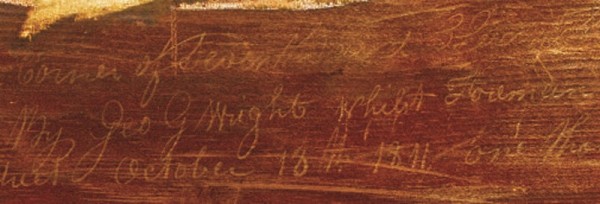
Detail of the inscription on the sideboard illustrated in fig. 1. (Photo, Gavin Ashworth.)
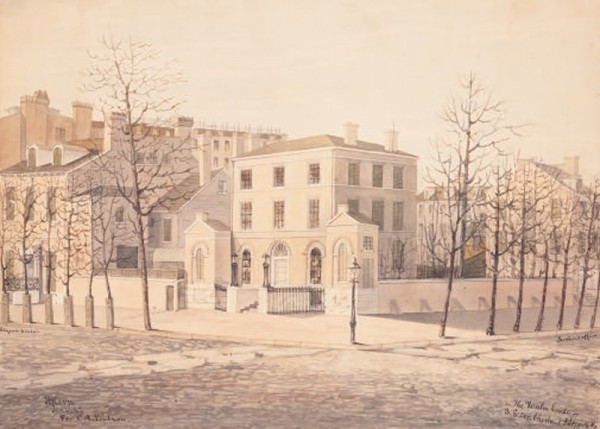
A. C. Kern, The Waln House—S. E. Cor. Chestnut & Seventh ST., Philadelphia, Pennsylvania, 1847. Watercolor and ink wash on paper. 11" x 15 1/2". (Courtesy, Library Company of Philadelphia.)

Side chair designed by B. Henry Latrobe, Philadelphia, Pennsylvania, ca. 1808. Yellow poplar, oak, maple, and white pine; painted, gessoed, and gilded ornament. H. 34 1/2", W. 19 3/4", D. 19 1/2". (Courtesy, Philadelphia Museum of Art.)
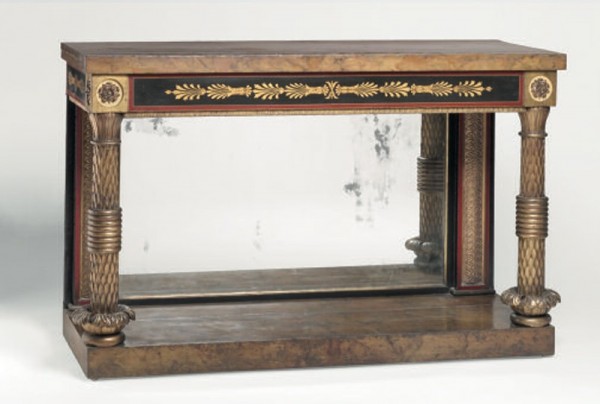
Pier table designed by B. Henry Latrobe, Philadelphia, Pennsylvania, ca. 1808. Yellow poplar and white pine; painted, gessoed, and gilded ornament; silvered glass, pot metal, and yellow cut velvet. H. 41 1/2", W. 66", D. 23". (Courtesy, Philadelphia Museum of Art.) The backboard is inscribed “Thos: Wetherill.” His uncle Samuel Wetherill was a paint manufacturer patronized by Latrobe and Bridport.

Card table designed by B. Henry Latrobe, Philadelphia, Pennsylvania, ca. 1808. Yellow poplar, maple, and white pine; painted, gessoed, and gilded ornament. H. 29 1/2", W. 36", D. 17 7/8". (Courtesy, Kaufman Americana Collection; photo, Gavin Ashworth.) This table is one of a pair. They are among the earliest American examples with swivel mechanisms for their tops.

Pier table made under George Wright’s supervision by Joseph B. Barry & Son, Philadelphia, Pennsylvania, 1810–1813. Mahogany and satinwood, mahogany and burl veneers with poplar; gilt bronze mounts and cast brass moldings. H. 38 5/8", W. 53 7/8", D. 23 7/8". (Courtesy, Metropolitan Museum of Art, Museum Purchase 1976; photo, Gavin Ashworth.) Like the pier table illustrated in fig. 6, this example was made without feet. This architectonic detail amplified the mass of both objects. Wright may have done everything but the carving.

Detail of George Wright’s initials on the pier table illustrated in fig. 8. (Photo, Gavin Ashworth.)

Detail of George Wright’s inscription “Jos B. Barry & Son” on the pier table illustrated in fig. 8. (Photo, Gavin Ashworth.)

Design for a pier table illustrated on pl. 10, no. 2 in Pierre de La Mésangère. Collection de Meubles et Objets de Goût (1802). (Courtesy, Metropolitan Museum of Art, Harris Brisbane Dick Fund, 1930 [30.80.1]. Image © Metropolitan Museum of Art.)
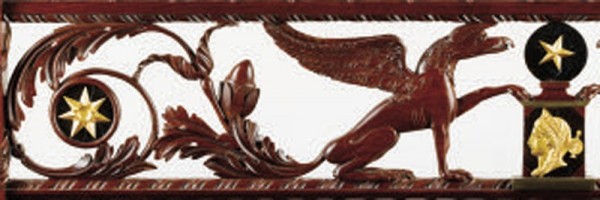
Detail of the carving on the pier table illustrated in fig. 8. (Photo, Gavin Ashworth.)

Design for a frieze or tablet illustrated on pl. 36 in Thomas Sheraton’s The Cabinet-Maker and Upholsterer’s Drawing Book (1791). (Courtesy, Philadelphia Museum of Art.)

Detail of the label on the pier table illustrated in fig. 8. Barry’s shop was located at 132 South Second Street in 1804 and 1805. (William Macpherson Hornor Jr., Blue Book Philadelphia Furniture [Philadelphia: By the author, 1935], pl. 432.)
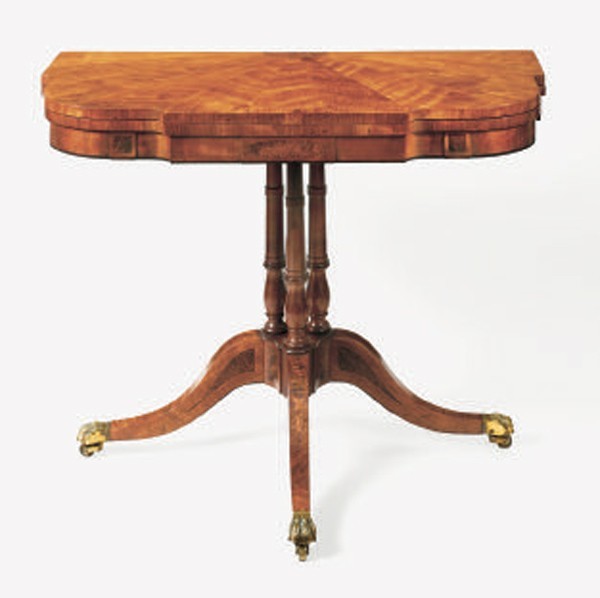
George G. Wright, card table, Philadelphia, Pennsylvania, 1813. Satinwood and satinwood, birch, and burl veneers with mahogany and white pine. H. 30", W. 38 1/4", D. 20 1/8". (Private collection; photo, Gavin Ashworth.) On a mechanical card table the two rear legs are hinged to swing back simultaneously as the leaf supports rotate out, thereby supporting the table as its center of gravity shifts owing to the top opening. An iron rod running through the pillar is attached to a series of pivoting iron bars housed in a box underneath the top of the table and to iron straps on the underside of the legs. This structure is found on both rear pillars of this table.
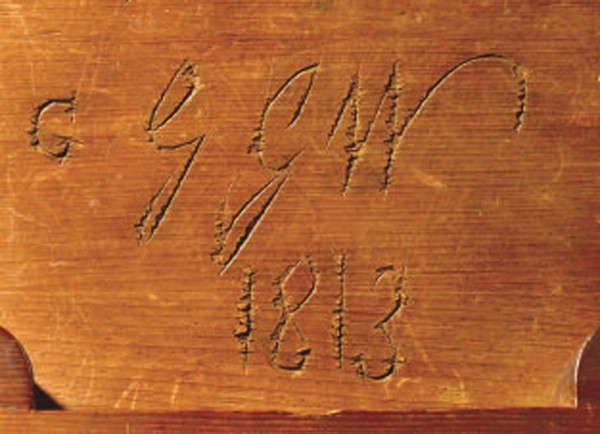
Detail of George Wright’s initials and the date 1813 cut into the underside of the card table illustrated in fig. 15. (Photo, Gavin Ashworth.)

Michael Allison, card table, New York City, ca. 1810. Mahogany with unidentified secondary woods. (From the Collections of the Henry Ford Museum.) This table is one of a pair representing the only documented New York examples of the “mechanical” form known.
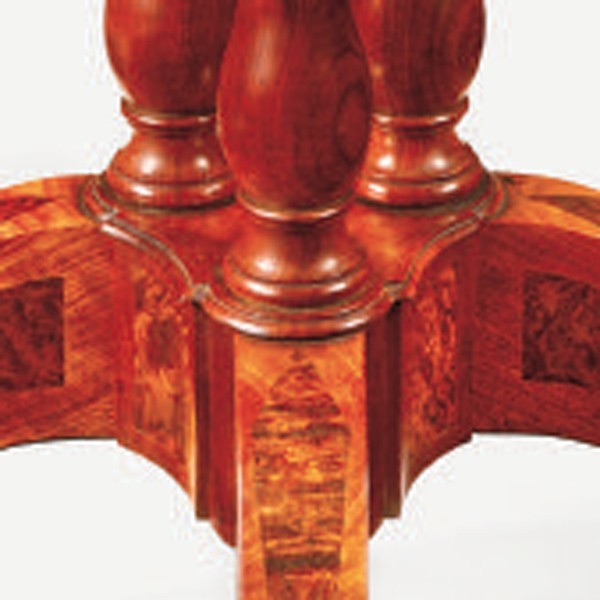
Detail of the plinth of the card table illustrated in fig. 15. (Photo, Gavin Ashworth.)
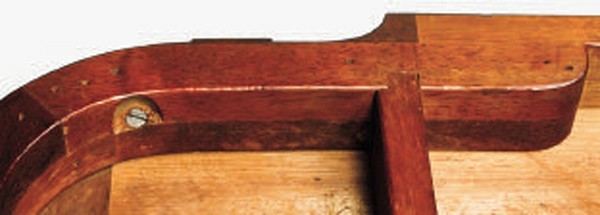
Detail of the apron construction of the card table illustrated in fig. 15. (Photo, Gavin Ashworth.)
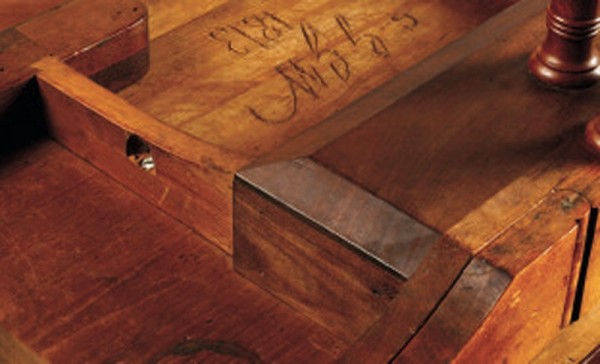
Detail of the rear rail and mechanical system of the card table illustrated in fig. 15. The mechanism box is made of mahogany and beveled on three sides. The paired struts forming the short sides are half-dovetailed into the front rails. (Photo, Gavin Ashworth.)
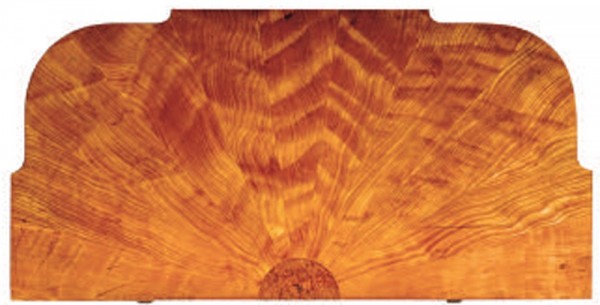
Detail of the top of the card table illustrated in fig. 15. When veneering tops in this pattern, Wright always used an odd number of rays to ensure symmetry and to have one segment centered at the front. The underside of the fly leaves and the tops of the stationary leaves of these tables are veneered with single flitches of what appears to be birch. The edges of the tops are crossbanded with the same wavy satinwood used in the rays. (Photo, Gavin Ashworth.)
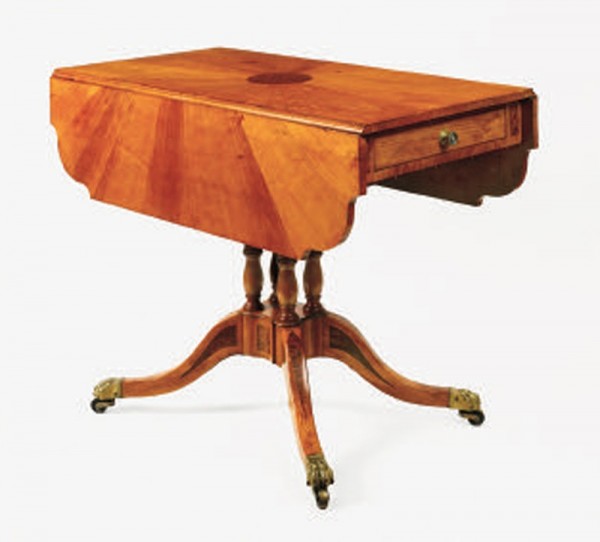
George G. Wright, breakfast table, Philadelphia, Pennsylvania, 1813. Satinwood and satinwood, mahogany, birch, and burl veneers with mahogany, white pine and yellow pine. H. 30", W. 36 1/4", D. 18". (Private collection; photo, Gavin Ashworth.)
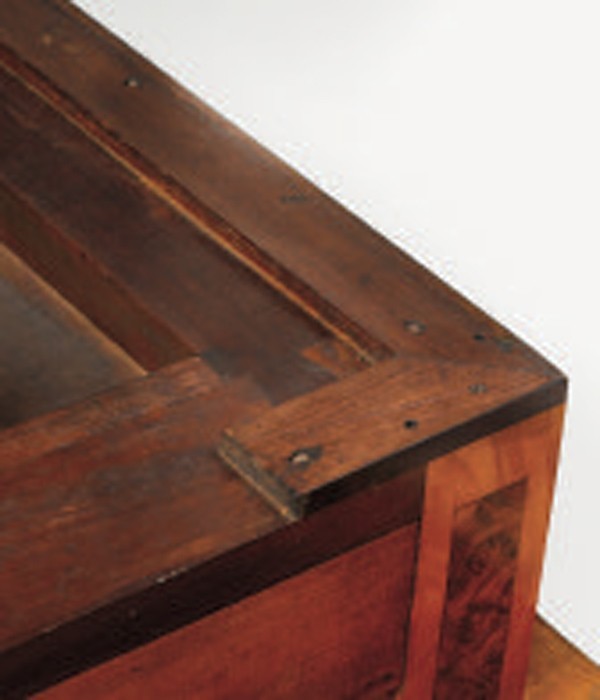
Detail of the crossbanding under the drawers of the breakfast table illustrated in fig. 22. The underside of the apron is tooth-planed beneath the strips housing the crossbanding. (Photo, Gavin Ashworth.)
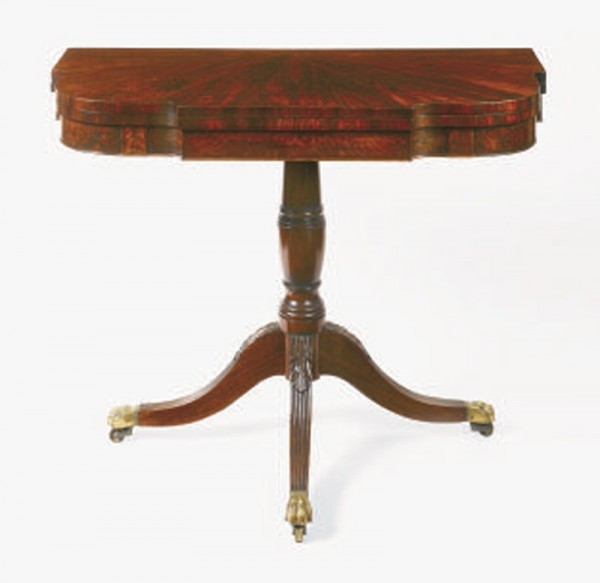
Card table attributed to George G. Wright, Philadelphia, Pennsylvania, 1813–1815. Mahogany and mahogany veneer with white pine and oak. H. 29 5/8", W. 36", D. 18". (Private collection; photo, Gavin Ashworth.)
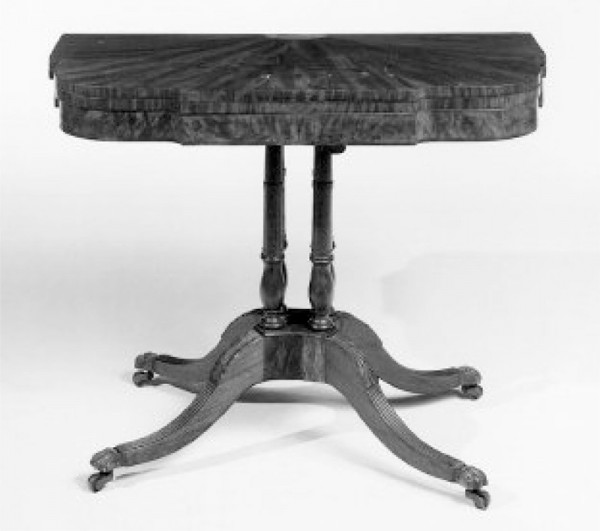
Card table attributed to George G. Wright, Philadelphia, Pennsylvania, 1813–1817. Mahogany and mahogany veneer with unidentified secondary woods. H. 28 1/2", W. 37", depth not recorded. (Courtesy, Photo Archives, National Gallery of Art.) The table descended in the Biddle, Priestley, and Lyon families of Philadelphia.
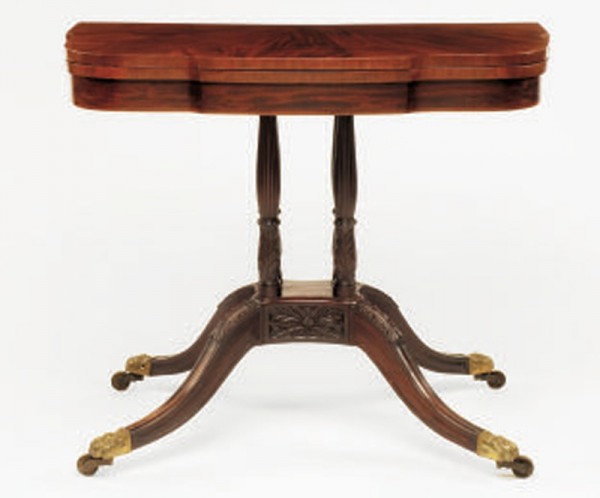
Card table attributed to George G. Wright, Philadelphia, Pennsylvania, 1815–1817. Mahogany and mahogany veneer with white pine and white cedar. H. 30", W. 35 3/4", D. 19 1/4". (Courtesy, Winterthur Museum.) The secondary surfaces of this table are covered with a red wash, or “pinking.” Several similar tables attributed to Wright are known. A pair made for Robert and Elizabeth Barnhill of Philadelphia (Sewell C. Biggs Museum of American Art) have playing surfaces covered in broadcloth and edged with mahogany veneer. The Journeyman Cabinet and Chair Makers’ Pennsylvania Book of Prices (1811) referred to that edge treatment as “lipping the top for cloth.” Another card table differs primarily in the execution of its carving (Northeast Auctions, The Charles V. Swain Collection of Pewter, Portsmouth, New Hampshire, February 24, 2007, lot 849).

Detail of the playing surface of the card table illustrated in fig. 26. (Photo, Gavin Ashworth.)
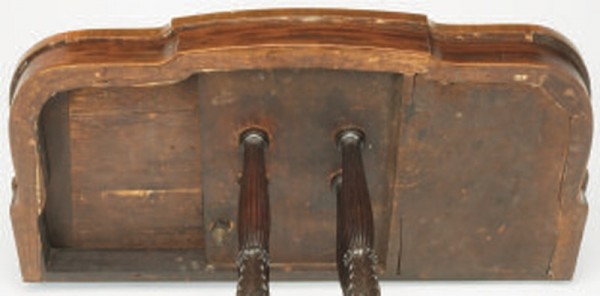
Detail of the lower edge of the apron of the card table illustrated in fig. 26. (Photo, Gavin Ashworth.)
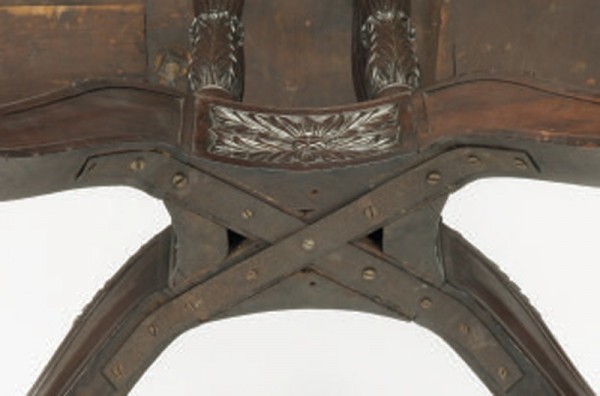
Detail of the plinth construction of the card table illustrated in fig. 26. (Photo, Gavin Ashworth.)
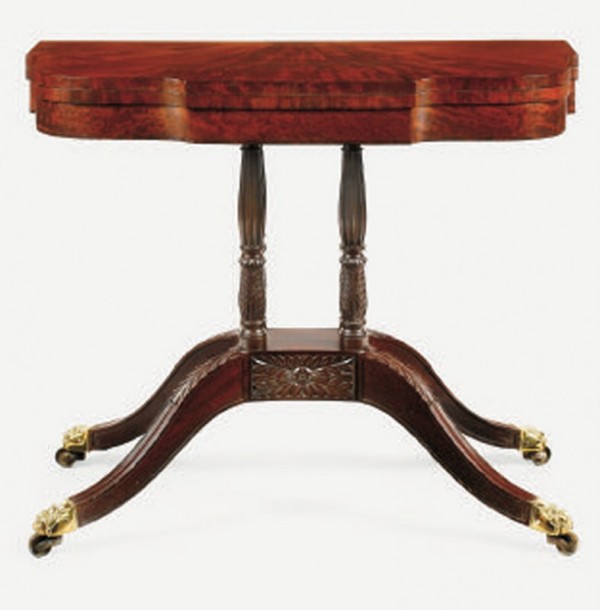
Card table attributed to George G. Wright, Philadelphia, Pennsylvania, 1815–1817. Mahogany and mahogany veneers with white pine. H. 30", W. 35 3/4", D. 18 1/2". (Private collection; photo, Gavin Ashworth.) This table is one of a pair.

Detail of the apron construction of the card table illustrated in fig. 30. (Photo, Gavin Ashworth.) The underside is tooth-planed, indicating that it originally had strips of contrasting wood.
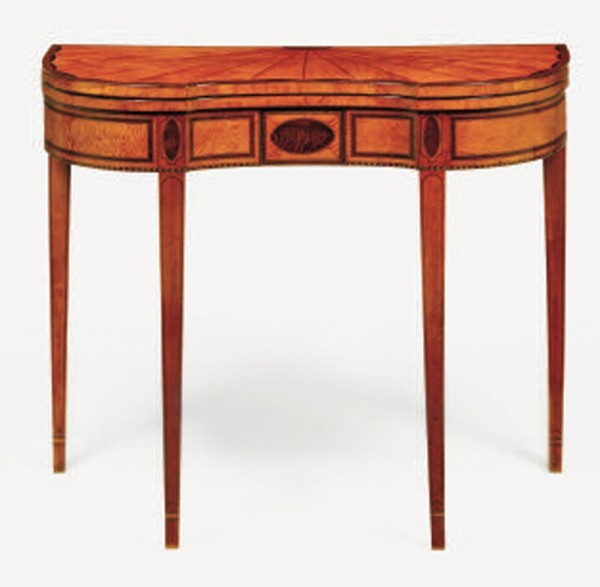
Robert McGuffin, card table, Philadelphia, Pennsylvania, 1807. Satinwood and satinwood, mahogany, and rosewood veneers with white pine and oak. H. 29 1/2", W. 35 5/8", D. 18". (Courtesy, Kaufman Americana Collection; photo, Gavin Ashworth.) McGuffin was a journeyman in Henry Connelly’s shop when he made this table. It is one of a pair.

Detail of the top of the card table illustrated in fig. 32. (Photo, Gavin Ashworth.)
